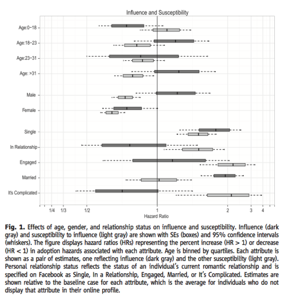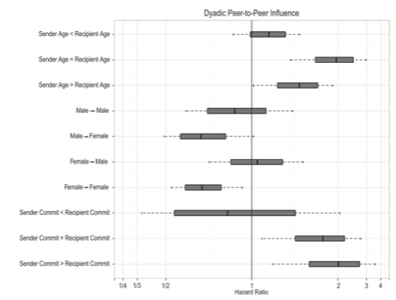Social media marketers have long focused on finding “influencers” on Facebook to spread a message or promote a product. New research suggests they’re missing half of the equation.
Social media experts spend a lot of time talking about influencers, people who are most effective at pushing a message and getting their contacts to respond to it. Less often discussed is susceptibility, or the idea that some people are more likely than others to be influenced by online social networks.
A new study by New York University’s Sinan Aral and Dylan Walker gauged susceptibility among 1.3 million Facebook users, making it is one of the most ambitious efforts yet to measure this phenomenon. Among the key findings, as reported in the July issue of Science:
- Younger users are more susceptible to influence than older users.
- Men are more influential than woman.
- Women influence men more than they influence other women.
- Married people are the least susceptible to influence in the decision to adopt products.
The biggest takeaway for marketers and others trying to spread messages through social media may be that influential Facebook users are less susceptible to influence than non-influential ones, and influencers tend to cluster in the network. In other words, finding influencers isn’t enough. The key to successfully spreading a message on Facebook, according to the study, is to find influencers with influential friends.

The researchers look beyond marketing, suggesting that “accurately identifying influential and susceptible individuals in networks could enable new behavioral interventions to affect obesity, smoking, exercise, fraud” as well as the adoption of new products and services.
Understanding Homophily
One of the biggest problems researchers have had in measuring influence on digital social networks is homophily, or the idea that people choose friends based on similar tastes and preferences. Did you influence a friend to see The Dark Knight Rises, or were you connected in the first place because you both like Batman?
Aral and Walker were able to control for that in their study by using randomized experiments. While some homophily and peer some influence may have crept into their results, they worked around the homophily problem by letting study subjects randomly share opinions about films with some but not all of their friends, coupled with the large sample.
“It’s Complicated”

Not surprisingly, people tend to hold the most influence over people in their age range, the researchers found. And, generally speaking, the older a person is, the more influential and less susceptible he or she is on Facebook.
But the study dug deeper, finding that Facebook users in an equally or more-committed relationship tend to hold more sway over peers. The most susceptible users? People who listed their relationship as “It’s complicated.”
Influence Adopters, Not Influencers
Social networking advertising targeted specifically at women may be ineffective, the data suggested, although the researchers said more study was needed. That’s because women are more likely to adopt messages spontaneously while having 22% less influence on peers than the average Facebook user.
For now, the best marketing strategy is to target influencers who have already adopted a product, the researchers said. Individuals who already use a product can be given incentives to influence their peers, as opposed to giving individuals with susceptible peers incentives to adopt a product.
That’s because more people are influential than susceptible on Facebook, and targeting individuals who are influential only because they have susceptible peers may be a wasted effort. The key is finding the clusters of influential users within a social network to get a message disseminated as quickly as possible.










